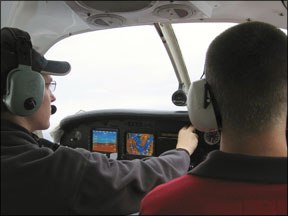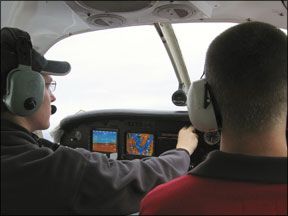Perhaps youve heard the riddle, “What do you call the person who graduates at the bottom of the class in medical school?” The answer: Doctor. The maxim being conveyed applies equally well to aviation: What do you call the pilot who has met the minimum standards set forth in FAR 61.183-187? Answer: Certificated Flight Instructor. Yet whether acting in the capacity of doctor or flight instructor, that individual is directly responsible for another persons well being. Others literally may live or die based directly on the doctors and the flight instructors knowledge and skills. 288 The path to becoming a practicing doctor evolved to include a rigorous course of study and years of apprenticeship: college, med school, internship, residency, fellowship. The tradition in aviation, on the other hand, has been to treat flight instructing as the bullpen for corporate and airline flying. Still clinging to this model, many instructors teach largely for their own benefit and not the benefit of their students. Instructing, after all, is supposed to be a transient phase; building time, the primary goal; low pay and high turnover at flight schools, expected. Predictable Results It shouldnt be surprising, then, that quality in flight training has suffered under this model. It shouldnt be surprising, either, that a majority of aviation accidents follow similar patterns fitting neatly into just a few categories: maneuvering flight, stalls, spins-the last things encountered in far too many accidents. The NTSBs accident analyses not only tell us what happened in the past, but also predict the future if we continue to ignore the core mistakes perpetrated during training. Pilots typically will only be as competent as the training they receive. All too often, a flight instructors weaknesses become a students bad habits; an instructors mythology, a students reality; and an instructors fear, a students terror. If the instructor does not know what the elevator controls, for instance, the student will not know either. And if the instructor does not recognize the human tendency to underestimate risk, it is unreasonable to assume that the student will be able to manage risk effectively. The cycle repeats itself as the student becomes the teacher, and our national training system falls farther out of calibration. Case in point: Two instructor-level studies published in the last 15 years have exposed gaping holes in the stall/spin expertise of our corps of flight instructors. Nearly 1000 CFIs and 30 designated pilot examiners from across the country were surveyed. Seventy-eight percent reported they received an hour or less of formal ground instruction in stall/spin academics prior to receiving their FAA-mandated spin endorsements. And slightly more than half of them didnt get any ground training whatsoever. Sixty-nine percent of the instructors surveyed had performed four or fewer spin entries for their spin endorsements, with slightly more than half experiencing a grand total of two spin entries. Eighty percent had spun only one or two different models of aircraft. Its also quite likely the maneuvers performed did not represent aircraft behavior in the broader spin envelope. Given the significant role the stall/spin plays in aviation accidents, such marginal competency in stall/spin awareness is unacceptable at the instructor level. Also unacceptable is the general lack of a strong, visceral sense of cause and effect during maneuvering flight and the ability to convey that vital information to students. In this era of traditional aircraft designs, technically advanced aircraft, and burgeoning light sport and very light jet markets, the safety and vitality of an entire industry rests on the CFIs shoulders. We must demand greater proficiency from our instructors. This in no way is meant to besmirch the many wonderful and talented instructors out there. Yet in a country where one in seven pilots are CFIs, the first-rate ones tend to be the exception when we should be demanding that they be the norm. Recalibrating the System Reducing training errors and omissions must begin at the flight instructor level. While poring over FARs, becoming intimately familiar with airspace and sectional charts, and learning how to use high-tech equipment certainly have their place in the training of new instructors, aviation safety ultimately boils down to how well pilots can maneuver their airplanes. Consequently, flight instructor applicants really need to hone their situational awareness and stick-and-rudder skills. They need to become experts in stall/spin awareness, risk management and maneuvering flight. Its time the flight instructor certification process was treated as a path to a stand-alone profession in its own right. Spin endorsements need to reflect true competency; we must demand that applicants demonstrate a genuine ability to teach stalls and spins. And upon becoming a CFI, the importance of continuing education must be stressed and encouraged as well. The Master Instructor designation program administered by the National Association of Flight Instructors offers one way for instructors to grow as professional educators. Training to minimum standards doesnt imply that flight-critical errors and omissions are acceptable. Quite the opposite; pilots need to be taught in a way thats consistent with the laws of aerodynamics right from the start. A tactile as well as an intellectual understanding of the fundamentals needs to be fostered and reinforced on each and every training flight. Proactive risk mitigation demands that pilots become better at maneuvering, that pilots become well informed about, and practiced in, stall/spin awareness, and that pilots squelch the urge to turn back to the runway should the engine quit. Instructors mustnt simply show their pupils what they need to pass a test. Instructors must teach their students what they need to 
The Transcendent Pilot
Flying well is not accomplished through a series of unrelated, compartmentalized thoughts and movements. Competently piloting an airplane is rooted in five primary actions: controlling bank with ailerons; controlling yaw with rudder; controlling angle of attack with elevator (manifested as changes in speed, G-load, and turning); controlling altitude with power; and maintaining a cerebral sense of your place in the operating environment past, present and future. Blending the four control actions in the proper proportions yields the flight maneuvers we are familiar with. Developing the knack for knowing precisely what, how and when to blend the controls takes practice-practice of the right things, the right way.
Rich Stowell has logged nearly 19,000 landings in a diverse assortment of light airplanes. His newest book, The Light Airplane Pilots Guide to Stall/Spin Awareness, was released earlier this year.




